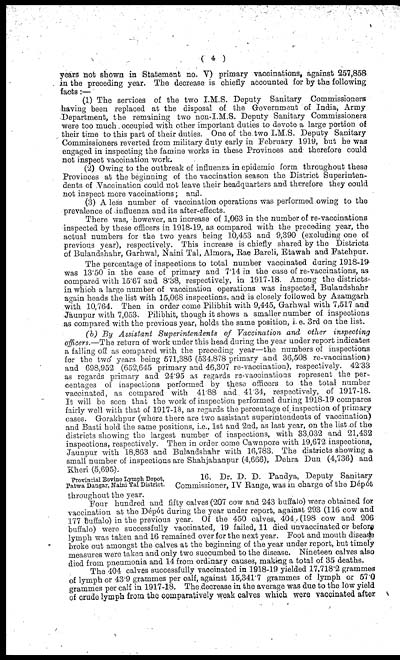Medicine - Vaccination > 1902-1928 - Report on vaccination in the United Provinces > Vaccination United Provinces of Agra and Oudh 1914-1922 > Notes on vaccination in the United Provinces of Agra and Oudh for the year ending 31st March, 1919
(231) Page 4
Download files
Individual page:
Thumbnail gallery: Grid view | List view

( 4 )
years not shown in Statement no. V) primary vaccinations, against 257,858
in the preceding year. The decrease is chiefly accounted for by the following
facts:—
(1) The services of the two I.M.S. Deputy Sanitary Commissioners
having been replaced at the disposal of the Government of India, Army
Department, the remaining two non I.M.S. Deputy Sanitary Commissioners
were too much occupied with other important duties to devote a large portion of
their time to this part of their duties. One of the two I.M.S. Deputy Sanitary
Commissioners reverted from military duty early in February 1919, but he was
engaged in inspecting the famine works in these Provinces and therefore could
not inspect vaccination work.
(2) Owing to the outbreak of influenza in epidemic form throughout these
Provinces at the beginning of the vaccination season the District Superinten-
dents of Vaccination could not leave their headquarters and therefore they could
not inspect more vaccinations ; and.
(3) A less number of vaccination operations was performed owing to the
prevalence of influenza and its after-effects.
There was, however, an increase of 1,063 in the number of re-vaccinations
inspected by these officers in 1918-19, as compared with the preceding year, the
actual numbers for the two years being 10,453 and 9,390 (excluding one of
previous year), respectively. This increase is chiefly shared by the Districts
of Bulandshahr, Garhwal, Naini Tal, Almora, Rae Bareli, Etawah and Fatehpur.
The percentage of inspections to total number vaccinated during 1918-19
was 13.50 in the case of primary and 7.14 in the case of re-vaccinations, as
compared with 15.67 and 8.38, respectively, in 1917-18. Among the districts
in which a large number of vaccination operations was inspected, Bulandshahr
again heads the list with 15,068 inspections, and is closely followed by Azamgarh
with 10,764. Then in order come Pilibhit with 9,445, Garhwal with 7,517 and
Jaunpur with 7,053. Pilibhit, though it shows a smaller number of inspections
as compared with the previous year, holds the same position, i. e. 3rd on the list.
(b) By Assistant Superintendents of Vaccination and other inspecting
officers.—The return of work under this head during the year under report indicates
a falling off as compared with the preceding year—the numbers of inspections
for the two years being 571,386 (534,878 primary and 36,508 re-vaccination)
and 698,952 (652,645 primary and 46,307 re-vaccination), respectively. 42.33
as regards primary and 24.95 as regards re-vaccinations represent the per-
centages of inspections performed by these officers to the total number
vaccinated, as compared with 41.88 and 41.34, respectively, of 1917-18.
It will be seen that the work of inspection performed during 1918-19 compares
fairly well with that of 1917-18, as regards the percentage of inspection of primary
cases. Gorakhpur (where there are two assistant superintendents of vaccination)
and Basti hold the same positions, i.e., 1st and 2nd, as last year, on the list of the
districts showing the largest number of inspections, with 33,032 and 21,432
inspections, respectively. Then in order come Cawnpore with 19,672 inspections,
Jaunpur with 18,863 and Bulandshahr with 16,783. The districts showing a
small number of inspections are Shahjahanpur (4,666), Dehra Dun (4,736) and
Kheri (5,695).
Provincial Bovine Lymph Depot,
Patwa Dangar, Naini Tal District.
16. Dr. D. D. Pandya, Deputy Sanitary
Commissioner, IV Range, was in charge of the Dépôt
throughout the year.
Four hundred and fifty calves (207 cow and 243 buffalo) were obtained for
vaccination at the Dépôt during the year under report, against 293 (116 cow and
177 buffalo) in the previous year. Of the 450 calves, 404,(198 cow and 206
buffalo) were successfully vaccinated, 19 failed, 11 died unvaccinated or before
lymph was taken and 16 remained over for the next year. Foot and mouth disease
broke out amongst the calves at the beginning of the year under report, but timely
measures were taken and only two succumbed to the disease. Nineteen calves also
died from pneumonia and 14 from ordinary causes, making a total of 35 deaths.
The 404 calves successfully vaccinated in 1918-19 yielded 17,718.2 grammes
of lymph or 43.9 grammes per calf, against 15,341.7 grammes of lymph or 57.0
grammes per calf in 1917-18. The decrease in the average was due to the low yield
of crude lymph from the comparatively weak calves which were vaccinated after
Set display mode to: Large image | Zoom image | Transcription
Images and transcriptions on this page, including medium image downloads, may be used under the Creative Commons Attribution 4.0 International Licence unless otherwise stated. ![]()
| Permanent URL | https://digital.nls.uk/90473427 |
|---|
| Attribution and copyright: |
|
|---|




